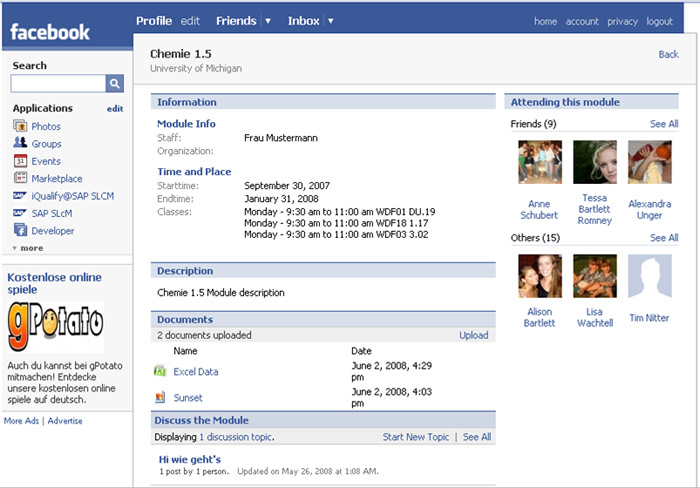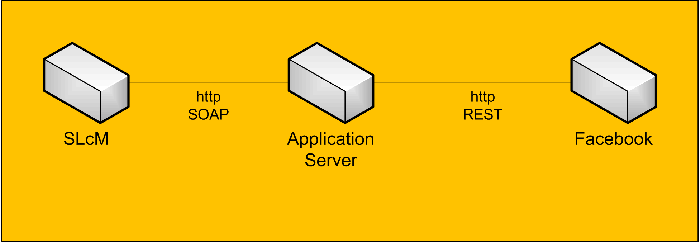SAP Higher Education and Research developed a prototype that enables students to access their university's schedule from their Facebook profile. In this blog we talk about the important role of Social Networks in student's everyday lives, introduce an example application, and show you how we brought these two systems together. You'll be surprised how easy it is!Social networks are a new channel for students' everyday communication. A study carried out by the USA's National School Board Association (NSBA) says that Nine- to 17-year-olds report spending almost as much time using social networking services and Web sites as they spend watching television. Among teens, that amounts to about 9 hours a week on social networking activities, compared to about 10 hours a week watching TV. They are chatting with friends, writing them messages, play games, setup events where they can meet, share pictures and videos or even trade goods.
This is where we realized that Facebook and our Student Lifecycle Management system (SLcM) would perfectly work together. While students apparently organize their lives more and more via Social Networks, universities manage their students' lives with the help of the SLcM for many years now. It is the place where are all the student data is stored and kept up to date by the university's staff. Enabling Social Networks to access this data, thus allowing students to keep connected with their university, was the natural conclusion.
We created a prototype application, which we called "MySchedule". Student's can add this application to their Facebook account and will then be able to access their universities schedule from within the Social Network. The student will be presented an overview of his weekly classes. By selecting any of these classes he will be directed to the detailed view of this class, where he or she can get detailed information, up- and download documents and images, and chat with other students by using a discussion board. The application makes use of Facebook's social graph, by bringing together the student's friend list, and SLcM's list of users that participate in the course. This way the student gets an overview of all his friends that are with him in the course, as well as those people he doesn't know yet, but might like to get in contact with.

The next figure shows the data-flow model of the prototype. The application itself is hosted on a regular webserver. It's up to the universities if they want to host the application on their own or on an outside server. In our example we used an apache server supporting PHP and MySQL. The MySQL database saves the relation between Facebook User-ID and SLcM StudentobjectID. This allows the application, after the initial registration process, to identify the corresponding Student Object every time the student logs into Facebook.
All student data is provided via webservices by the Student Lifecycle Management system. On the other, side the application communicates to Facebook via a RESTful API that provides all social information about the user, like the friends list, hobbies, or activities.

We furthermore created a second version of the same application, using the Open Social API. Open Social is supported by all big Social Networks (like MySpace, Ning, LinkedIn, Xing, Friendster, Orkut, etc.), with the exception of Facebook. What makes Open Social so great is that it allows us to write one application and apply it on several Social Networks with only minor changes. The goal could be to support every major Social Network, and allow the Student to choose his or her favorite platform herself.
We hope that this blog gave you a quick insight to our Facebook project. We believe that creating mashup-applications including this exciting new communication channel and the existing functionality provided by our SAP products can lead to valuable new use-cases for our customers.
